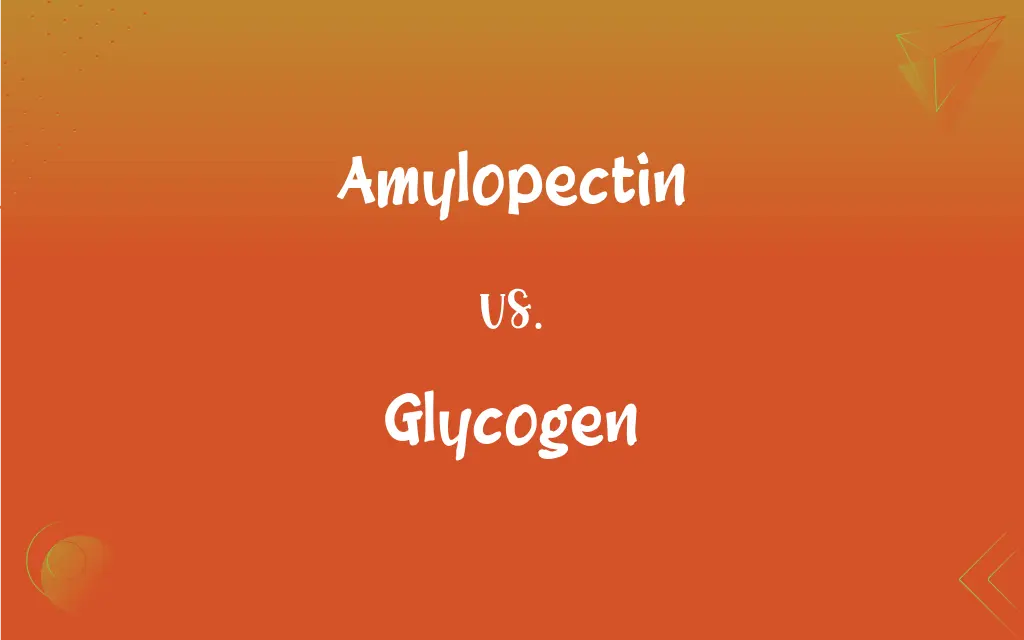Amylopectin vs. Glycogen: What's the Difference?
Edited by Janet White || By Harlon Moss || Published on November 27, 2023
Amylopectin is a branched polysaccharide of plants, while glycogen is the main storage polysaccharide in animals.

Key Differences
Amylopectin and glycogen are both polysaccharides, but they are found in different organisms. Amylopectin is one of the two components of starch, primarily found in plants, and plays a significant role in energy storage. On the other hand, glycogen, sometimes referred to as "animal starch," is stored mainly in the liver and muscles of animals, supplying them with a quick source of energy.
Amylopectin has a slightly less branched structure compared to glycogen. This means that while both molecules store glucose units, the way they branch and organize these units varies. Glycogen's more frequent branching allows for rapid glucose release, suitable for the quick energy needs of animals.
In terms of solubility and structure, amylopectin's branching is at intervals of 20-30 glucose units, which contributes to its semi-crystalline nature in starch granules. Glycogen, with its more frequent branching every 8-12 glucose units, is highly soluble and doesn't form a crystalline structure like amylopectin.
To sum it up, while both amylopectin and glycogen serve as energy storage molecules, they differ in their structure, branching frequency, and the organisms they are found in. Amylopectin is a primary component in plant starch, whereas glycogen is predominant in animals.
Comparison Chart
Source
Found in plants.
Found in animals, mainly in the liver and muscles.
ADVERTISEMENT
Branching Interval
Branches every 20-30 glucose units.
Branches more frequently, every 8-12 glucose units.
Crystallinity
Forms semi-crystalline structures in starch granules.
Highly soluble and doesn't form crystalline structures.
Role
Major component of starch for energy storage in plants.
Main storage polysaccharide in animals for quick energy release.
Structure Complexity
Slightly less branched compared to glycogen.
Highly branched structure.
Amylopectin and Glycogen Definitions
Amylopectin
Stores glucose in plants.
Corn has a high amylopectin content, giving it its waxy texture.
ADVERTISEMENT
Glycogen
The main storage polysaccharide in animals.
The liver stores excess glucose as glycogen for later use.
Amylopectin
Found in various plants like maize and potato.
The amylopectin in rice is responsible for its sticky nature when cooked.
Glycogen
Stored primarily in the liver and muscles.
After a meal, the body replenishes its glycogen stores.
Amylopectin
Major component of starch.
The semi-crystalline nature of some starches is due to amylopectin.
Glycogen
Highly branched structure.
The structure of glycogen allows for rapid glucose release.
Amylopectin
A branched polysaccharide in plants.
Starch is composed of amylopectin and amylose.
Glycogen
Breaks down to release glucose.
During exercise, glycogen reserves are tapped for energy.
Amylopectin
Has fewer branches than glycogen.
The structure of amylopectin is different from that of glycogen due to its branching pattern.
Glycogen
Known as "animal starch."
Glycogen's role in animals is analogous to starch in plants.
Amylopectin
A highly branched polysaccharide of high molecular weight that is one of the two main components, along with amylose, of starches.
Glycogen
A polysaccharide, (C6H10O5)n, that is the main form of carbohydrate storage in animals and is found primarily in the liver and muscle tissue. It is readily converted to glucose as needed by the body to satisfy its energy needs. Also called animal starch.
Amylopectin
(carbohydrate) A highly branched, insoluble form of starch (the soluble form being amylose)
Glycogen
(carbohydrate) A polysaccharide that is the main form of carbohydrate storage in animals; converted to glucose as needed.
Glycogen
A white, amorphous, tasteless substance resembling starch, soluble in water to an opalescent fluid. It is found abundantly in the liver of most animals, and in small quantity in other organs and tissues, particularly in the embryo. It is quickly changed into sugar when boiled with dilute sulphuric or hydrochloric acid, and also by the action of amylolytic ferments.
Glycogen
One form in which body fuel is stored; stored primarily in the liver and broken down into glucose when needed by the body
FAQs
What is the role of glycogen in animals?
Glycogen serves as the main storage form of glucose, providing quick energy.
Is amylopectin found in animals?
No, amylopectin is primarily found in plants as a component of starch.
How does the body utilize glycogen during fasting?
The body breaks down glycogen to release glucose for energy during fasting.
Which has more branching: amylopectin or glycogen?
Glycogen has more frequent branching compared to amylopectin.
Are amylopectin and glycogen the same?
No, they differ in structure, branching, and the organisms they are found in.
Do all plants contain amylopectin?
Most plants that store starch will contain amylopectin, but the content can vary.
Does amylopectin have a role in plant energy storage?
Yes, amylopectin, as a part of starch, stores energy in plants.
Is the crystallinity of starch attributed to amylopectin?
Yes, the semi-crystalline nature of some starches is due to amylopectin.
What happens to muscle glycogen during intense exercise?
During intense exercise, muscle glycogen is broken down to provide energy.
Which is more complex in structure, amylopectin or glycogen?
Glycogen is more complex due to its higher degree of branching.
Why is glycogen's branching significant?
The extensive branching allows for rapid release of glucose for energy.
Can humans digest amylopectin?
Yes, humans can digest amylopectin as it's a component of starch.
Where is glycogen primarily stored in the body?
Glycogen is mainly stored in the liver and muscles.
How is glycogen replenished in the body?
Post meals, the body converts excess glucose into glycogen for storage.
Is amylopectin water-soluble?
Amylopectin is not highly water-soluble like some other polysaccharides.
Can humans store unlimited amounts of glycogen?
No, there's a limit to how much glycogen the liver and muscles can store.
Are there foods rich in amylopectin?
Yes, waxy corn and certain rice varieties have high amylopectin content.
Is glycogen found in plant cells?
No, plants store glucose as starch, which includes amylopectin, not glycogen.
Why is rice sticky when cooked?
The sticky nature of some rice varieties is due to their high amylopectin content.
How is glucose released from glycogen?
Enzymes break down glycogen to release glucose when needed.
About Author
Written by
Harlon MossHarlon is a seasoned quality moderator and accomplished content writer for Difference Wiki. An alumnus of the prestigious University of California, he earned his degree in Computer Science. Leveraging his academic background, Harlon brings a meticulous and informed perspective to his work, ensuring content accuracy and excellence.
Edited by
Janet WhiteJanet White has been an esteemed writer and blogger for Difference Wiki. Holding a Master's degree in Science and Medical Journalism from the prestigious Boston University, she has consistently demonstrated her expertise and passion for her field. When she's not immersed in her work, Janet relishes her time exercising, delving into a good book, and cherishing moments with friends and family.






































































